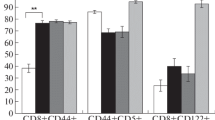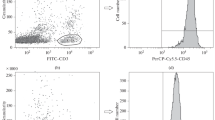Abstract
Three bovine serum albumin-specific Lyt-2+ T suppressor (Ts) cell clones from CBA/J mice have been analyzed with regard to expression of L3T4 molecules. All three Ts-cell clones can be stained with monoclonal antibodies (mAb) to L3T4. Tested for the two clones restricted to recognition of Ek determinants, antigen-specific proliferation on antigen-presenting cells, but not the proliferation induced by conditioned medium can be inhibited by L314-specific mAb. In a similar way, Ts-cell cytolytic effector functions can be blocked by L3T4-specific mAb. Thus L3T4 structures seem to play a role in Ts-cell functions. Furthermore, the data support the view that L3T4 expression can be a property of class II-restricted T cells irrespective of their Lyt phenotype.
Similar content being viewed by others
References
Asano, Y. and Hodes, R. J.: T cell regulation of B cell activation. I-A-restricted T suppressor cells inhibit the major histocompatibility complex-restricted interactions of T helper cells with B cells and accessory cells. J. Exp. Med. 157: 1867–1884, 1983
Baxevanis, C. N., Ishii, N., Nagy, Z. A., and Klein, J.: Role of the Ek molecule in the generation of suppressor T cells in response to LDHB. Scand. J. Immunol. 16: 25–31, 1982
Brunner, K. T., Mauel, J., Cerottini, J. C., and Chapus, B.: Quantitative assay of the lytic action of immune lymphoid cells on 51Cr-labeled allogeneic target cells in vitro: Inhibition by isoantibody and by drugs. Immunology 14: 181–196, 1968
Cantor, H. and Boyse, E. A.: Functional subclasses of T lymphocytes bearing different Ly antigens. I. The generation of functionally distinct T cell subclasses is a differentiative process independent of antigen. J. Exp. Med. 141: 1376–1389, 1975
Crispe, I. N., Bevan, M. J., and Staerz, V. D.: Selective activation of Lyt-2+ precursor T cells by ligation of the antigen receptor. Nature 317: 627–629, 1985
DeKruyff, R., Clayberger, C., Cantor, H., and Dorf, M. E.: Activation requirements of cloned inducer T cells. I. Differential inhibition by anti-L3T4 or anti-I-A is determined by the accessory cell population. J. Immunol. 135: 2243–2248, 1985
Dialynas, D. P., Wilde, D. B., Marrack, P., Pierces, A., Wall, K. A., Harvan, W., Otten, G., Loken, M. R., Kappler, J., and Fitch, F. W. Characterization of the murine antigenic determinant, designated L3T4a, recognized by monoclonal antibody GK1.5: Expression of L3T4a by functional T cell clones appears to correlate primarily with class II MHC antigen-reactivity. Immunol. Rev. 74: 29–56, 1983
Golding, H., Munitz, T. I., and Singer, A.: Characterization of antigenspecific Ia-restricted, L3T4+ cytolytic T lymphocytes and assessment of thymic influence on their self specificity. J. Exp. Med. 162: 943–961, 1985a
Golding, H., McCluskey, J., Munitz, T. I., Germain, R. N., Margulies, D. H., and Singer, A.: T-cell recognition of a chimaeric class II/class I MHC molecule and the role of L3T4. Nature 317: 425–427, 1985b
Gougeon, M. L., Bismuth, G., and Theze, S.: Differential effects of monoclonal antibodies anti-L3T4 and anti-LFAl on the antigeninduced proliferation of Thelper cell clones: Correlation between their susceptibility to inhibition and their affinity for antigen. Cell. Immunol. 95: 75–83, 1985
Greenstein, J. L., Malissen, B., and Bukeroff, S. J.: Role of L3T4 in antigen-driven activation of a class I-specific T cell hybridoma. J. Exp. Med. 162: 369–374, 1985
Heuer, J. and Kölsch, E.: Functional studies on the role of I-A molecules expressed by the antigen-specific T suppressor cell clone HFI. J. Immunol. 134: 4031–4034, 1985
Heuer, J. and Kölsch, E.: Selective elimination through a cytolytic mechanism of bovine serum albumin specific T helper lymphocyte by T suppressor cells with the same antigen-specificity. Eur. J. Immunol. 16: 400–404, 1986
Heuer, J., Brüner, K., Opalka, B., and Kölsch, E.: A cloned T -cell line from a tolerant mouse represents a novel antigen-specific suppressor cell type. Nature 296: 456–459, 1982
Heuer, J., Opalka, B., Rassat, J., Themann, H., and Kölsch, E.: Characterization of the cytolytic activity of a cloned antigen-specific T suppressor cell derived from a tolerant CBA/J mouse. Eur. J. Immunol. 13: 551–555, 1983
Heuer, J., Kölsch, E., and Reske, K.: Expression and function of class II I-Ak antigens on an antigen-specific T suppressor cell clone. Curr. Top. Microbiol. 126: 131–138, 1986
Kaplan, D. R., Henkel, T. J., Braciale, V., and Baraciale, T. J.: Mycoplasma infection of cell cultures: Thymidine incorporation of culture supernatants as a screening test. J. Immunol. 132: 9–11, 1984
Kiessling, R., Klein, E., and Wigzell, H.: “Natural” killer cells in the mouse. I. Cytotoxic cells with specificity for mouse Moloney leukemia cells. Specificity and distribution according to genotype. Eur. J. Immunol. 5: 112–121, 1975
Koch, N., Arnold, B., Hämmerling, G., Heuer, J., and Kölsch, E.: Structural comparison of I-A antigens produced by a cloned murine T suppressor cell line with B-cell-derived I-A. Immunogenetics 17: 497–505, 1983
Kölsch, E., Stumpf, R., and Weber, G.: Low zone tolerance and suppressor T cells. Transplant. Rev. 26: 56–86, 1975
Ledbetter, J. A. and Herzenberg, L. A.: Xenogeneic monoclonal antibodies to mouse lymphoid differentiation antigens. Immunol. Rev. 47: 63–90, 1979
Lemke, H., Hämmerling, G. J., and Hämmerling, U.: Fine specificity analysis with monoclonal antibodies of antigens controlled by the major histocompatibility complex and by the Qua/TL region in mice. Immunol. Rev. 47: 175–206, 1979
Malek, T. R., Chan, C., Glimcher, L. H., Germain, R. N., and Shevach, E. M.: Influence of accessory cell and T cell surface antigens on mitogen-induced IL-2 receptor expression. J. Immunol. 135: 1826–1833, 1985
Marrack, P., Enders, R., Shimonkevitz, R., Zlotnik, A., Dialynas, D., Fitch, F., and Kappler, J.: The major histocompatibility complexrestricted antigen receptor on T cells. II. Role of the L3T4 product. J. Exp. Med. 158: 1077–1091, 1983
Mathieson, B. L. and Fouwlkes, B. J.: Cell surface antigen expression on thymocytes: Development and phenotypic differentiation of intrathymic subsets. Immunol. Rev. 82: 141–173, 1984
Ozato, K., Mayer, N., and Sachs, D. H.: Hybridoma cell lines secreting monoclonal antibodies to mouse H-2 and Ia antigens. J. Immunol. 124: 533–540, 1980
Pierres, A., Naquet, P., Van Agthoven, A., Bekkhoucha, F., Denizot, F., Mistral, Z., Schmitt Verhulst, A. M., and Pierres, M.: A rat antimouse T4 monoclonal antibody (H129.19) inhibits the proliferation of Ia-reactive T cell clones and delineates two phenotypically distinct (T4+, Lyt-2.3− and T4−, Lyt-2,3+) subsets among anti-Ia cytolytic T cell clones. J. Immunol. 132: 2775–2782, 1984
Scollay, R., Bartlett, P., and Shortman, K.: T cell development in the adult murine thymus: Changes in the expression of the surface antigens Ly2, L3T4 and B2A2 during development from early precursor cells to emigrants. Immunol. Rev. 82: 79–103, 1984
Swain, S. L.: Significance of Lyt phenotypes: Lyt2 antibodies block activities of T cells that recognize class I major histocompatibility complex antigens regardless of their function. Proc. Natl. Acad. Sci. U.S.A. 78: 7101–7105, 1981
Swain, S. L., Dialynas, D. P., Fitch, F. W., and English, M.: Monoclonal antibody to L3T4 blocks the function of T cells specific for class H major histocompatibility complex antigens. J. Immunol. 132: 1118–1123, 1984
Wassmer, P., Chan, C., Lögdberg, L., and Shevach, E. M.: Role of the L3T4 antigen in T cell activation. II. Inhibition of T cell activation by monoclonal anti-L3T4 antibodies in the absence of accessory cells. J. Immunol. 135: 2237–2242, 1985
Wilde, D. B., Marrack, P., Kappler, J., Dialynas, D. P., and Fitch, F.W.: Evidence implicating L3T4 in class II MHC antigen reactivity: Monoclonal antibody GK1.5 (anti-L3T4a) blocks class II MHC antigen-specific proliferation, release of lymphokines, and binding by cloned murine helper T lymphocyte lines. J. Immunol. 131: 2178–2183, 1983
Author information
Authors and Affiliations
Rights and permissions
About this article
Cite this article
Heuer, J., Degwert, J. & Kölsch, E. Expression of L3T4 molecules on Lyt-2+, class II-restricted antigen-specific T suppressor lymphocytes. Immunogenetics 24, 316–323 (1986). https://doi.org/10.1007/BF00395537
Received:
Revised:
Issue Date:
DOI: https://doi.org/10.1007/BF00395537




